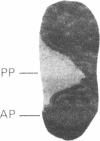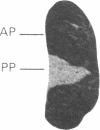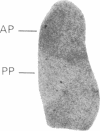Abstract
Angiotensin II has been implicated in the regulation of adrenocorticotropin and vasopressin secretion. Angiotensin II may influence the secretion of these hormones either directly at the pituitary gland or by increasing corticotropin-releasing hormone or vasopressin release from cells that are located in the paraventricular hypothalamic nucleus. Pituitary hormone release may also be influenced by circulating angiotensin II through receptors outside the blood-brain barrier in the subfornical organ. We have used alterations in angiotensin II receptors in hypophysectomized, adrenalectomized, and vasopressin-deficient Brattleboro rats as indicators of the activity of angiotensin II in the regulation of adrenocorticotropin and vasopressin secretion. Angiotensin receptor number in the paraventricular nucleus and the subfornical organ, but not in the anterior pituitary gland, was significantly decreased by adrenalectomy, and this effect was reversed by corticoids. Vasopressin deficiency decreased angiotensin receptors in the subfornical organ and increased them in the anterior pituitary gland but did not affect angiotensin II binding in either magnocellular or parvocellular subnucleus of the paraventricular nucleus. Our results suggest that angiotensin II may have a corticoid-dependent role in the regulation of corticotropin-releasing hormone secretion, which could be important in the adaptation to elevated corticosterone secretion in stress.
Full text
PDF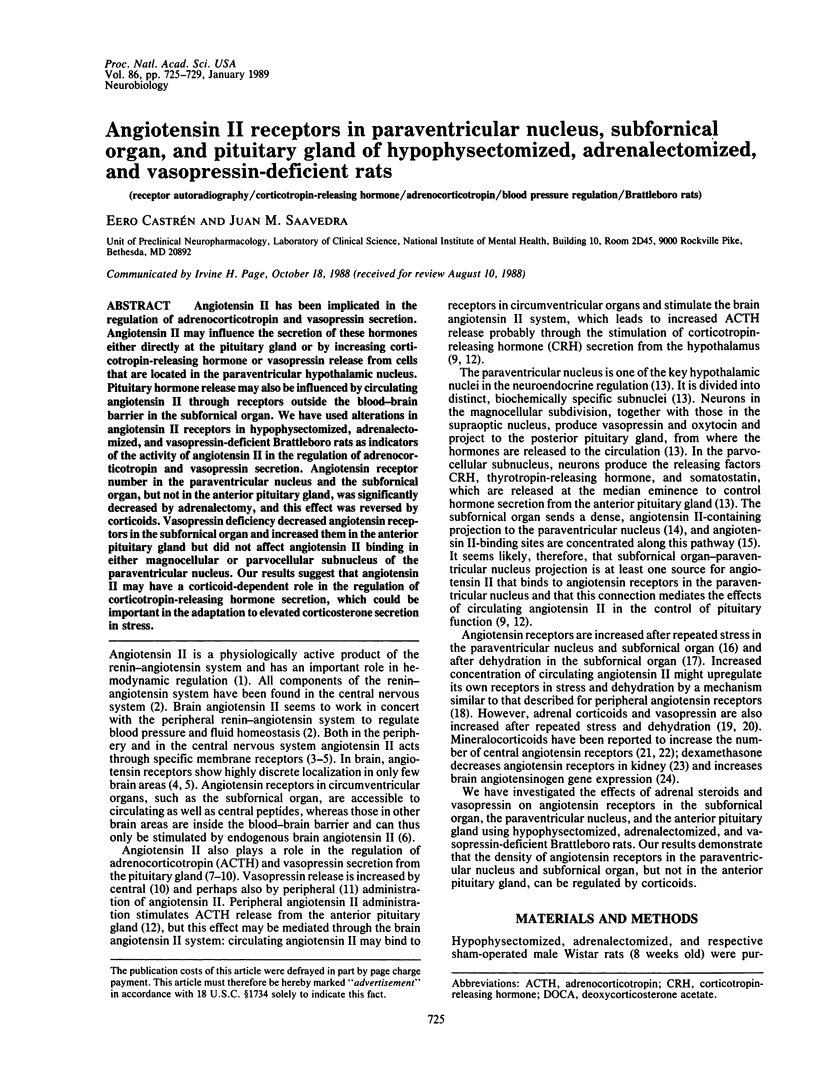
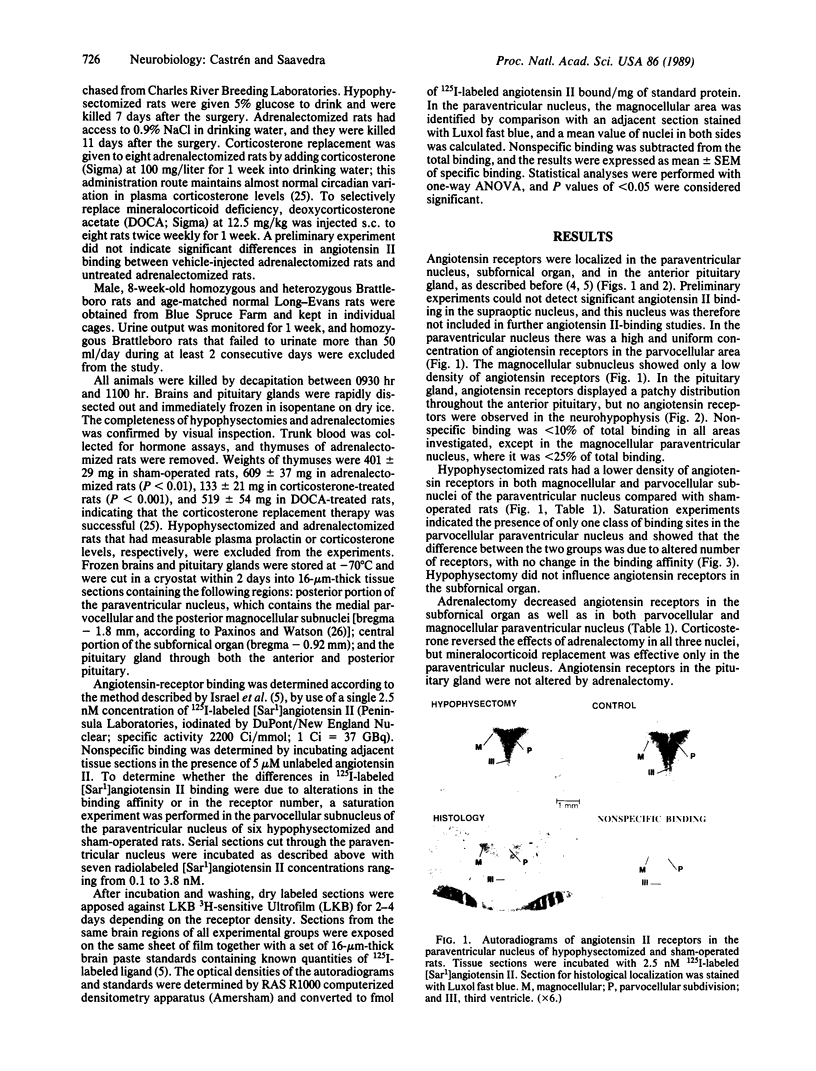

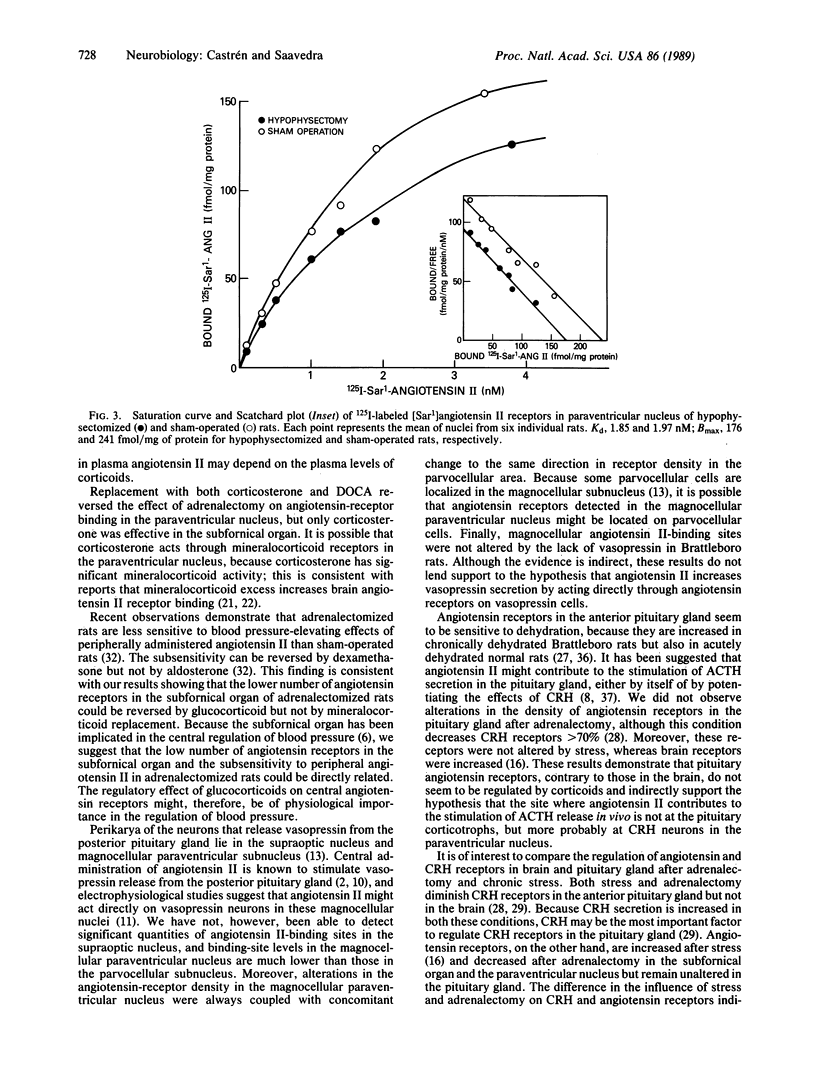
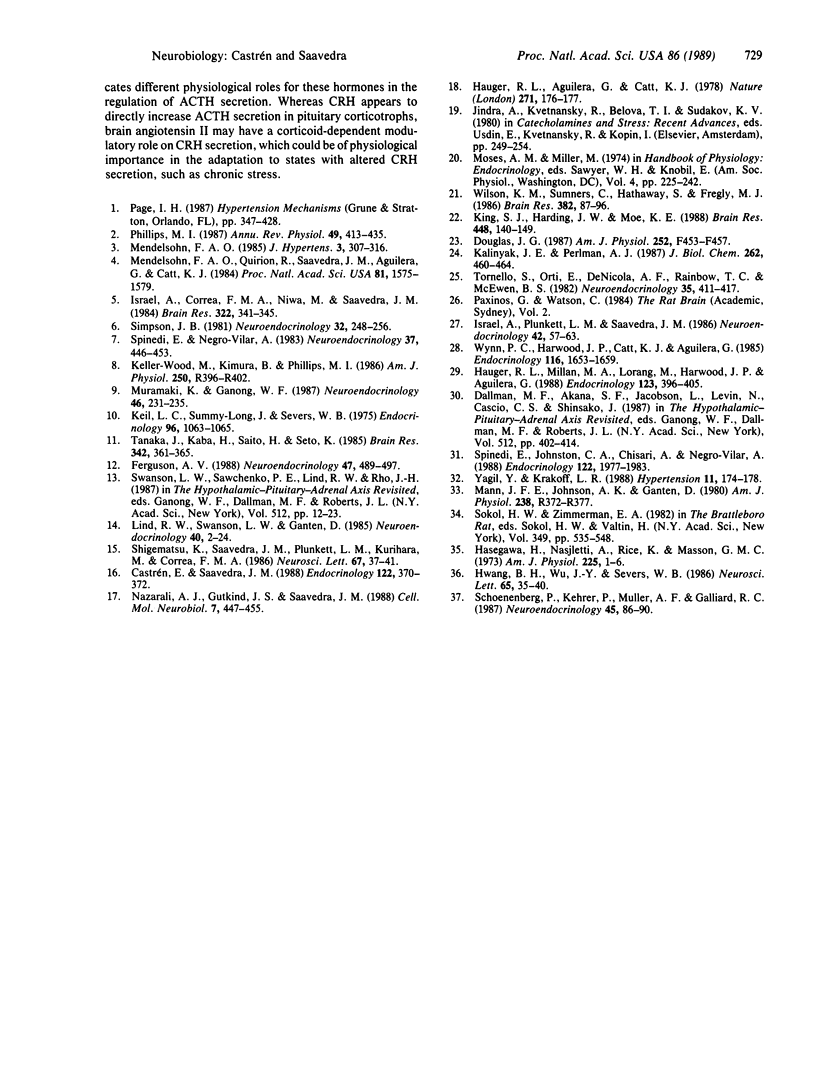
Images in this article
Selected References
These references are in PubMed. This may not be the complete list of references from this article.
- Castren E., Saavedra J. M. Repeated stress increases the density of angiotensin II binding sites in rat paraventricular nucleus and subfornical organ. Endocrinology. 1988 Jan;122(1):370–372. doi: 10.1210/endo-122-1-370. [DOI] [PubMed] [Google Scholar]
- Dallman M. F., Akana S. F., Jacobson L., Levin N., Cascio C. S., Shinsako J. Characterization of corticosterone feedback regulation of ACTH secretion. Ann N Y Acad Sci. 1987;512:402–414. doi: 10.1111/j.1749-6632.1987.tb24976.x. [DOI] [PubMed] [Google Scholar]
- Douglas J. G. Corticosteroids decrease glomerular angiotensin receptors. Am J Physiol. 1987 Mar;252(3 Pt 2):F453–F457. doi: 10.1152/ajprenal.1987.252.3.F453. [DOI] [PubMed] [Google Scholar]
- Ferguson A. V. Systemic angiotensin acts at the subfornical organ to control the activity of paraventricular nucleus neurons with identified projections to the median eminence. Neuroendocrinology. 1988 Jun;47(6):489–497. doi: 10.1159/000124960. [DOI] [PubMed] [Google Scholar]
- Hasegawa H., Nasjletti A., Rice K., Masson G. M. Role of pituitary and adrenals in the regulation of plasma angiotensinogen. Am J Physiol. 1973 Jul;225(1):1–6. doi: 10.1152/ajplegacy.1973.225.1.1. [DOI] [PubMed] [Google Scholar]
- Hauger R. L., Aguilera G., Catt K. J. Angiotensin II regulates its receptor sites in the adrenal glomerulosa zone. Nature. 1978 Jan 12;271(5641):176–178. doi: 10.1038/271176a0. [DOI] [PubMed] [Google Scholar]
- Hauger R. L., Millan M. A., Lorang M., Harwood J. P., Aguilera G. Corticotropin-releasing factor receptors and pituitary adrenal responses during immobilization stress. Endocrinology. 1988 Jul;123(1):396–405. doi: 10.1210/endo-123-1-396. [DOI] [PubMed] [Google Scholar]
- Hwang B. H., Wu J. Y., Severs W. B. Effects of chronic dehydration on angiotensin II receptor binding in the subfornical organ, paraventricular hypothalamic nucleus and adrenal medulla of Long-Evans rats. Neurosci Lett. 1986 Mar 28;65(1):35–40. doi: 10.1016/0304-3940(86)90116-3. [DOI] [PubMed] [Google Scholar]
- Israel A., Correa F. M., Niwa M., Saavedra J. M. Quantitative determination of angiotensin II binding sites in rat brain and pituitary gland by autoradiography. Brain Res. 1984 Nov 26;322(2):341–345. doi: 10.1016/0006-8993(84)90130-6. [DOI] [PubMed] [Google Scholar]
- Israel A., Plunkett L., Saavedra J. M. Increased number of angiotensin II binding sites determined by autoradiography in anterior pituitary of water-deprived and Brattleboro rats. Neuroendocrinology. 1986;42(1):57–63. doi: 10.1159/000124249. [DOI] [PubMed] [Google Scholar]
- Kalinyak J. E., Perlman A. J. Tissue-specific regulation of angiotensinogen mRNA accumulation by dexamethasone. J Biol Chem. 1987 Jan 5;262(1):460–464. [PubMed] [Google Scholar]
- Keil L. C., Summy-Long J., Severs W. B. Release of vasopressin by angiotensin II. Endocrinology. 1975 Apr;96(4):1063–1065. doi: 10.1210/endo-96-4-1063. [DOI] [PubMed] [Google Scholar]
- Keller-Wood M., Kimura B., Shinsako J., Phillips M. I. Interaction between CRF and angiotensin II in control of ACTH and adrenal steroids. Am J Physiol. 1986 Mar;250(3 Pt 2):R396–R402. doi: 10.1152/ajpregu.1986.250.3.R396. [DOI] [PubMed] [Google Scholar]
- King S. J., Harding J. W., Moe K. E. Elevated salt appetite and brain binding of angiotensin II in mineralocorticoid-treated rats. Brain Res. 1988 May 10;448(1):140–149. doi: 10.1016/0006-8993(88)91110-9. [DOI] [PubMed] [Google Scholar]
- Lind R. W., Swanson L. W., Ganten D. Organization of angiotensin II immunoreactive cells and fibers in the rat central nervous system. An immunohistochemical study. Neuroendocrinology. 1985 Jan;40(1):2–24. doi: 10.1159/000124046. [DOI] [PubMed] [Google Scholar]
- Mann J. F., Johnson A. K., Ganten D. Plasma angiotensin II: dipsogenic levels and angiotensin-generating capacity of renin. Am J Physiol. 1980 May;238(5):R372–R377. doi: 10.1152/ajpregu.1980.238.5.R372. [DOI] [PubMed] [Google Scholar]
- Mendelsohn F. A. Localization and properties of angiotensin receptors. J Hypertens. 1985 Aug;3(4):307–316. doi: 10.1097/00004872-198508000-00002. [DOI] [PubMed] [Google Scholar]
- Mendelsohn F. A., Quirion R., Saavedra J. M., Aguilera G., Catt K. J. Autoradiographic localization of angiotensin II receptors in rat brain. Proc Natl Acad Sci U S A. 1984 Mar;81(5):1575–1579. doi: 10.1073/pnas.81.5.1575. [DOI] [PMC free article] [PubMed] [Google Scholar]
- Murakami K., Ganong W. F. Site at which angiotensin II acts to stimulate ACTH secretion in vivo. Neuroendocrinology. 1987 Sep;46(3):231–235. doi: 10.1159/000124824. [DOI] [PubMed] [Google Scholar]
- Nazarali A. J., Gutkind J. S., Saavedra J. M. Regulation of angiotensin II binding sites in the subfornical organ and other rat brain nuclei after water deprivation. Cell Mol Neurobiol. 1987 Dec;7(4):447–455. doi: 10.1007/BF00733796. [DOI] [PubMed] [Google Scholar]
- Phillips M. I. Functions of angiotensin in the central nervous system. Annu Rev Physiol. 1987;49:413–435. doi: 10.1146/annurev.ph.49.030187.002213. [DOI] [PubMed] [Google Scholar]
- Schoenenberg P., Kehrer P., Muller A. F., Gaillard R. C. Angiotensin II potentiates corticotropin-releasing activity of CRF41 in rat anterior pituitary cells: mechanism of action. Neuroendocrinology. 1987 Jan;45(1):86–90. doi: 10.1159/000124707. [DOI] [PubMed] [Google Scholar]
- Shigematsu K., Saavedra J. M., Plunkett L. M., Kurihara M., Correa F. M. Angiotensin II binding sites in the anteroventral-third ventricle (AV3V) area and related structures of the rat brain. Neurosci Lett. 1986 Jun 6;67(1):37–41. doi: 10.1016/0304-3940(86)90204-1. [DOI] [PubMed] [Google Scholar]
- Simpson J. B. The circumventricular organs and the central actions of angiotensin. Neuroendocrinology. 1981 Apr;32(4):248–256. doi: 10.1159/000123167. [DOI] [PubMed] [Google Scholar]
- Sokol H. W., Zimmerman E. A. The hormonal status of the Brattleboro rat. Ann N Y Acad Sci. 1982;394:535–548. doi: 10.1111/j.1749-6632.1982.tb37468.x. [DOI] [PubMed] [Google Scholar]
- Spinedi E., Johnston C. A., Chisari A., Negro-Vilar A. Role of central epinephrine on the regulation of corticotropin-releasing factor and adrenocorticotropin secretion. Endocrinology. 1988 May;122(5):1977–1983. doi: 10.1210/endo-122-5-1977. [DOI] [PubMed] [Google Scholar]
- Spinedi E., Negro-Vilar A. Angiotensin II and ACTH release: site of action and potency relative to corticotropin releasing factor and vasopressin. Neuroendocrinology. 1983 Dec;37(6):446–453. doi: 10.1159/000123591. [DOI] [PubMed] [Google Scholar]
- Tanaka J., Kaba H., Saito H., Seto K. Electrophysiological evidence that circulating angiotensin II sensitive neurons in the subfornical organ alter the activity of hypothalamic paraventricular neurohypophyseal neurons in the rat. Brain Res. 1985 Sep 9;342(2):361–365. doi: 10.1016/0006-8993(85)91137-0. [DOI] [PubMed] [Google Scholar]
- Tornello S., Orti E., De Nicola A. F., Rainbow T. C., McEwen B. S. Regulation of glucocorticoid receptors in brain by corticosterone treatment of adrenalectomized rats. Neuroendocrinology. 1982 Dec;35(6):411–417. doi: 10.1159/000123429. [DOI] [PubMed] [Google Scholar]
- Wilson K. M., Sumners C., Hathaway S., Fregly M. J. Mineralocorticoids modulate central angiotensin II receptors in rats. Brain Res. 1986 Sep 10;382(1):87–96. doi: 10.1016/0006-8993(86)90114-9. [DOI] [PubMed] [Google Scholar]
- Wynn P. C., Harwood J. P., Catt K. J., Aguilera G. Regulation of corticotropin-releasing factor (CRF) receptors in the rat pituitary gland: effects of adrenalectomy on CRF receptors and corticotroph responses. Endocrinology. 1985 Apr;116(4):1653–1659. doi: 10.1210/endo-116-4-1653. [DOI] [PubMed] [Google Scholar]
- Yagil Y., Krakoff L. R. The differential effect of aldosterone and dexamethasone on pressor responses in adrenalectomized rats. Hypertension. 1988 Feb;11(2):174–178. doi: 10.1161/01.hyp.11.2.174. [DOI] [PubMed] [Google Scholar]







